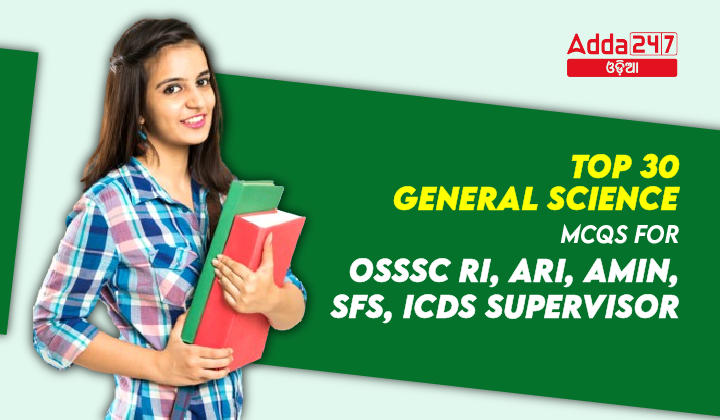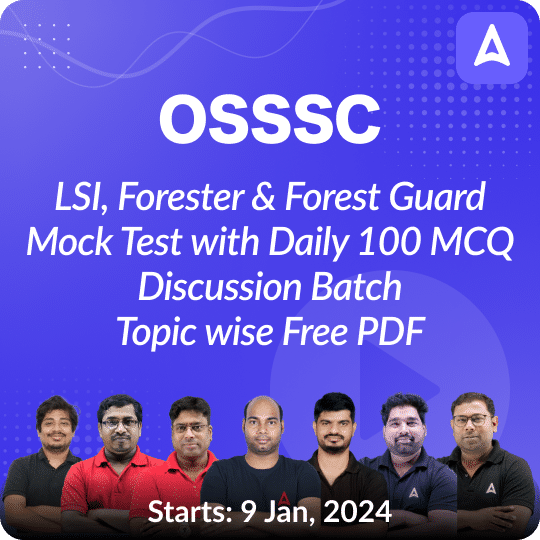OSSSC RI, ARI, Amin, SFS, ICDS Supervisor exams often include a section on general science to assess candidates’ knowledge of fundamental scientific principles. This article presents a curated list of 30 General Science Multiple Choice Questions (MCQs) suitable for individuals preparing for OSSSC RI, ARI, Amin, SFS, ICDS Supervisor exams. These questions are designed to challenge your understanding of current science .
Top 30 General Science MCQS For OSSSC RI,ARI, Amin, SFS, ICDS Supervisor
Mastering these general science concepts is crucial for success in competitive exams. Regular practice with such MCQs will not only enhance your knowledge but also improve your problem-solving skills. Remember to review the explanations for each answer to deepen your understanding of these fundamental scientific principles. Good luck with your preparations!
- Which two elements are the most and least electronegative in the periodic table?[A] Fluorine and Caesium
[B] Hydrogen and Helium
[C] Carbon and Oxygen
[D] Chlorine and Fluorine
Correct Answer: A [Fluorine and Caesium]Notes: Caesium is the least electronegative element, while Fluorine is the most electronegative. - Plasmodium falciparum, which causes malaria in humans, belongs to which group of organisms?[A] Bacteria
[B] Viruses
[C] Protozoans
[D] Fungi
Correct Answer: C [Protozoans]Notes: Plasmodium, the causative agent of malaria, is a type of protozoan parasite transmitted by mosquitoes. - Which of the following diseases is caused by Plasmodium falciparum?[A] Tuberculosis
[B] Influenza
[C] Malaria
[D] Dengue
Correct Answer: C [Malaria]Notes: Plasmodium falciparum is the deadliest species of Plasmodium and causes malaria in humans. - What is the primary mode of transmission of Plasmodium falciparum to humans?[A] Through contaminated food and water
[B] Through the bite of infected mosquitoes
[C] Through direct contact with infected individuals
[D] Through airborne droplets
Correct Answer: B [Through the bite of infected mosquitoes]Notes: Malaria is primarily transmitted to humans through the bite of female Anopheles mosquitoes infected with Plasmodium parasites. - Which of the following Plasmodium species is considered the most severe and potentially fatal?[A] Plasmodium vivax
[B] Plasmodium ovale
[C] Plasmodium malariae
[D] Plasmodium falciparum
Correct Answer: D [Plasmodium falciparum]Notes: Plasmodium falciparum causes severe and potentially life-threatening malaria in humans. - Which organ does Plasmodium falciparum primarily affect in the human body?[A] Liver
[B] Lungs
[C] Brain
[D] Kidneys
Correct Answer: C [Brain]Notes: Severe cases of Plasmodium falciparum infection can lead to cerebral malaria, affecting the brain and causing neurological symptoms. - What is the characteristic feature of Plasmodium falciparum-infected red blood cells?[A] They become enlarged
[B] They form rosettes with other infected cells
[C] They lose their ability to adhere to blood vessel walls
[D] They turn blue when stained with certain dyes
Correct Answer: B [They form rosettes with other infected cells]Notes: Infected red blood cells in Plasmodium falciparum malaria often form rosettes, which can lead to microvascular obstruction. - Which of the following is a common symptom of Plasmodium falciparum malaria?[A] Rash
[B] Joint pain
[C] High fever
[D] Persistent cough
Correct Answer: C [High fever]Notes: High fever, often accompanied by chills and sweating, is a characteristic symptom of Plasmodium falciparum malaria. - What is the characteristic smell of LPG gas due to?[A] Butane
[B] Propane
[C] Methane
[D] Ethanethiol
Correct Answer: D [Ethanethiol]Notes: Ethanethiol, also known as stench, is added to odorless gases like LPG to serve as a warning of gas leaks. - What causes Dengue, a disease commonly found in tropical and subtropical regions?[A] Bacteria
[B] Virus
[C] Fungi
[D] Protozoan
Correct Answer: B [Virus]Notes: Dengue is a mosquito-borne viral infection prevalent in tropical and subtropical regions. - Which of the following best describes a Silverfish?[A] A Fish
[B] A wingless Insect
[C] An Anthropod
[D] A frog
Correct Answer: B [A wingless Insect]Notes: Silverfish, scientifically known as Lepisma saccharina, are wingless insects belonging to the order Zygentoma. - What is the primary role of Ethanethiol in LPG gas?[A] Providing heat when burned
[B] Adding color to the gas
[C] Enhancing the smell for leak detection
[D] Increasing the pressure of the gas
Correct Answer: C [Enhancing the smell for leak detection] - What is the incubation period for Dengue symptoms to appear after infection?[A] 1-3 days
[B] 1-2 weeks
[C] 3-6 weeks
[D] 2-4 months
Correct Answer: B [1-2 weeks] - Which part of the world is Dengue commonly found in?[A] Arctic regions
[B] Temperate zones
[C] Tropical and subtropical regions
[D] Mediterranean climates
Correct Answer: C [Tropical and subtropical regions] - What is the scientific name of the mosquito that transmits Dengue virus?[A] Aedes aegypti
[B] Culex pipiens
[C] Anopheles gambiae
[D] Aedes albopictus
Correct Answer: A [Aedes aegypti] - Which physical characteristic makes Silverfish easily identifiable?[A] Bright coloration
[B] Presence of wings
[C] Fish-like appearance
[D] Long legs
Correct Answer: C [Fish-like appearance] - Which statement is correct regarding the saliva of a healthy human?[A] It is slightly acidic
[B] It is slightly saline
[C] It is slightly alkaline
[D] It is neutral
Correct Answer: C [It is slightly alkaline]Notes: The pH of healthy human saliva is slightly alkaline, typically ranging from 6.2 to 7.6. - In which year was India certified as being free of variola (smallpox virus) due to the Indian National Smallpox Eradication Programme (NSEP) and its intensified version (INSEP)?[A] 1975
[B] 1977
[C] 1980
[D] 1985
Correct Answer: B [1977]Notes: India was certified as being free of the smallpox virus in 1977 due to successful eradication efforts. - What is the pH range of healthy human saliva?[A] 1.0 to 3.0
[B] 4.0 to 6.0
[C] 6.2 to 7.6
[D] 8.0 to 10.0
Correct Answer: C [6.2 to 7.6] - What is the significance of the Indian National Smallpox Eradication Programme (NSEP)?[A] Eradicating malaria
[B] Eliminating tuberculosis
[C] Eradicating smallpox
[D] Controlling cholera outbreaks
Correct Answer: C [Eradicating smallpox] - Which of the following terms refers to the potential hydrogen level of a substance?[A] pKa
[B] pH
[C] pOH
[D] pCO2
Correct Answer: B [pH] - Which organization certified India as being free of the smallpox virus in 1977?[A] World Health Organization (WHO)
[B] Centers for Disease Control and Prevention (CDC)
[C] Indian Medical Association (IMA)
[D] United Nations Children’s Fund (UNICEF)
Correct Answer: A [World Health Organization (WHO)] - What is the origin of rotating black holes, also known as Kerr black holes?[A] Supernova explosion
[B] Neutron star collision
[C] White dwarf collapse
[D] Quasar formation
Correct Answer: A [Supernova explosion] - What is the nature of the core of a black hole?[A] Gravitational singularity
[B] Neutron star
[C] Dark matter
[D] Quasar
Correct Answer: A [Gravitational singularity] - What is the role of the event horizon in a black hole?[A] It prevents anything from entering the black hole.
[B] It marks the boundary beyond which nothing can escape the black hole’s gravity.
[C] It is the region where matter and energy are constantly ejected from the black hole.
[D] It is the point of origin for the black hole’s rotation.
Correct Answer: B [It marks the boundary beyond which nothing can escape the black hole’s gravity.] - What is the primary characteristic of the ergosphere of a rotating black hole?[A] It is smaller than the event horizon.
[B] It prevents anything from entering the black hole.
[C] It allows objects to enter and exit if moving rapidly.
[D] It is a region of complete darkness.
Correct Answer: C [It allows objects to enter and exit if moving rapidly.] - What does the term ‘ergosphere’ derive from?[A] Greek word ‘ergon,’ meaning ‘work’
[B] Latin word ‘terra,’ meaning ‘earth’
[C] Sanskrit word ‘shakti,’ meaning ‘power’
[D] Arabic word ‘jazeera,’ meaning ‘island’
Correct Answer: A [Greek word ‘ergon,’ meaning ‘work’] - What is the purpose of the C-CARES web portal developed by C-DAC for CMPFO?[A] Addressing the digitalization challenges of CMPFO
[B] Promoting environmental conservation
[C] Enhancing healthcare services for coal sector workers
[D] Facilitating international trade agreements
Correct Answer: A [Addressing the digitalization challenges of CMPFO] - Which ministry is responsible for overseeing CMPFO, an organization managing Provident Fund and Pension schemes for coal sector workers?[A] Ministry of Finance
[B] Ministry of Coal, Mines, and Parliamentary Affairs
[C] Ministry of Labour and Employment
[D] Ministry of Environment, Forest and Climate Change
Correct Answer: B [Ministry of Coal, Mines, and Parliamentary Affairs]When was CMPFO established?[A] 1948
[B] 1965
[C] 1975
[D] 1980
Correct Answer: A [1948]





